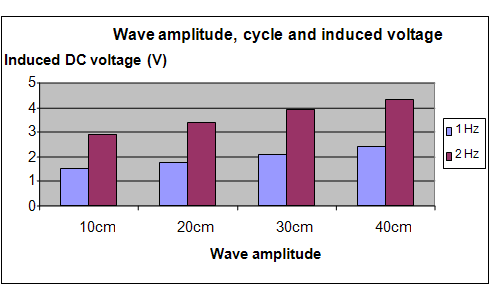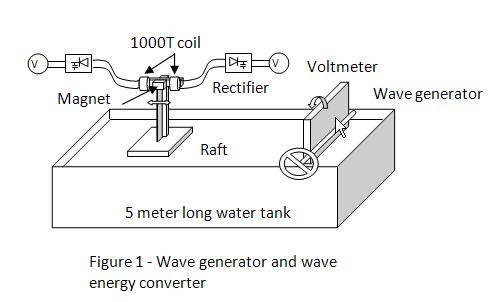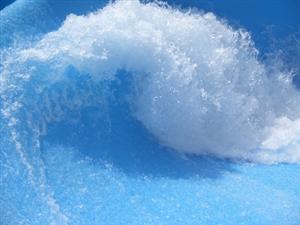| Complexity level: | 9 |
| Project cost ($): | 180 |
| Time required: | 2 days to prepare, 1 hour for the science project experiment |
| Material availability: | Parts required for assembly of our experiment apparatus may be purchased at a hardware/hobby store. |
| Safety concerns: | Basic safety requirements |
Hypothesis
The higher the frequency or the amplitude of a wave, the greater the voltage of electricity produced.
Overview
Wave power
Wave power refers to the harnessing of energy from the waves in the ocean. The energy of waves can be harvested and used for electricity generation. Wave energy is one of the most environmentally friendly and renewable energy sources, just like solar and wind power.
The waves on water surfaces are created by passing wind. Energy will be transferred from the wind to the waves as long as the speed of the wind is faster than that of the waves. The size of the waves is determined by the amount of friction caused by the wind on the water surface and also the "pressure gradient" occurring along the crest of the wave.
The height of the wave will depend on its speed and the duration for which the wind blows. Other factors that contribute to the wave's height are sea or river bed conditions, the depth of the ocean or river and the distance across which the wind blows. Generally speaking, bigger waves have more energy, but ultimately, the power generated by a wave depends on a variety of factors including the speed of the wave, its wavelength and the density of the water.
Scientific Terms
Materials
The materials required for this science fair project:
- a 5 meter long container (width 1 meter, depth 1 meter)
- a wave making device (with a turning wheel and wooden plank that acts as a rotating oar/paddle)
- 2 copper wire wound coils, 1000 turns each
- 1 strong magnet
- 1 metal plate (1 meter in length, 5 cm in width and 0.5 mm in thickness)
- 2 pieces of wood ( 1 meter and 0.5 meter in length)
- hammer and nails
- 1 wooden raft
- electric wires
- 2 rectifiers with capacitors
- tap water to fill the tank
- a digital voltmeter
- 1 masking tape
- an assistant
Procedure
1. For this science fair project, the independent variable is the height of the wave and the wave cycle period. The dependent variable is the voltage induced in the coils. This is determined by measuring the voltage using a digital voltmeter. The constants (control variables) are the strength of the magnet, the turns in the coil, the length of the metal plate, the depth of the water and the size of the raft.
2. The 5 meter long tank is filled with water and the wave generator is installed in the tank as shown in figure 1 below. By turning the wheel, the motion produced by the wooden plank will create waves. The cycle of the waves can be controlled by the speed at which the wheel turns. The amplitude of the wave can be increased or reduced by adjusting the wooden plank.
3. A wooden raft is prepared by nailing the 2 pieces of wood in a T-shape. The meter long piece of wood is placed vertically and the 0.5 meter piece of wood is placed horizontal. The coil is affixed to the wood using masking tape as shown in figure 1.

4. The magnet is mounted on the tip of the metal plate with the masking tape. The bottom of the metal plate is fixed to the raft. They are arranged as shown in figure 1. The swinging of the metal plate should cause the magnet to move towards the center of the coil and induce a voltage/current in the coil. .
5. Both coils are connected to the diode and capacitor rectifier. The DC voltage is measured at the output of the rectifier.
6. The waves are generated at 1 cycle per second (1 Hertz) and 2 cycles per second (2 Hertz) at wave amplitudes of 10 cm, 20 cm, 30 cm and 40 cm. The voltage generated is measured and recorded in the table below.


Results
The results showed that increasing the wave cycle and amplitude resulted in a higher electrical voltage.
|
Wave amplitude and wave cycle |
Induced voltage in coils (V) |
|||
|
10 cm |
20 cm |
30 cm |
40 cm |
|
|
1 Hertz |
1.5 |
1.8 |
2.1 |
2.4 |
|
2 Hertz |
2.9 |
3.4 |
3.9 |
4.3 |
The chart below represents the results of our science fair project experiment.

Conclusion
Our hypothesis that wave cycles at a higher frequency and at a higher amplitude will produce higher electrical voltages, is proven to be true.
Wave energy is produced by placing electric power generators on ocean surfaces. There are several methods such as the Pelamis wave energy converter, Anaconda wave energy converter and the Wave Dragon energy converter. The world’s first wave farm was built off the shores of Portugal using three 750kVA Pelamis wave converters.
Also consider
This science fair project may be repeated, to evaluate the impact of using water of a different density (eg. sea water). You could also try to make waves by blowing wind across the surface of the water using a large fan, and then changing the direction of the fan.
References
Wave power - http://en.wikipedia.org/wiki/Wave_power
Wave power - http://www.alternative-energy-news.info/technology/hydro/wave-power/
Starting to science fair project with wave power - http://www.creative-science.org.uk/wavegen.html

